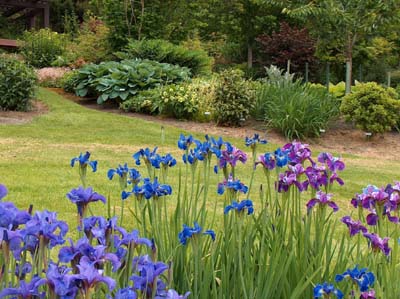Found native from central Europe to Asia the Siberian is one of the most adaptable irises for the perennial bed. Tetraploids (tet.) generally have stockier-looking flowers, foliage and stems than do diploids (dip.). All are deciduous and have a grass-like foliage. Bloom season is late May.

Planting: Newly received plants that are bare root should be soaked in cool water for a few hours or overnight. Plant 2 inches deep in a prepared bed, 18 to 24 inches apart. Water in well and keep moist until fall rains take over.
Soil:Prefers lose garden soil enriched with organic compost. Ph should be slightly acidic but will survive in slightly alkaline soils also.
Water: Once established very drought tolerant but would prefer a deep soaking every so often. Constant moisture in warm humid areas can encourage crown rot.
Light: Full sun with a minimum of 6 hours to bloom properly. Afternoon shade in hot areas will benefit bloom.
Mulching: A mulch of 2 to 4 inches is recommended. This will keep the soil cool, retain moisture, and suppress weeds.
Fertilizer: Siberians are moderate to light feeders. A light application of a well balanced fertilizer once a year right after bloom in beneficial.
Transplanting: Siberan iris can be transplanted almost anytime from spring until fall if you keep the plant moist and the temperatures are below 90 F and above 32 F for a month afterwards. Dig and divide your plants every 4 to 6 years for plant vigor. Plants should be broken down to 2 or 4 healthy fans, removing the old crowns and roots. Plant 2 or 3 inches deep in new soils that have been worked up and amended. Your best bloom will be on 2 to 6 year old plants.
Winter Dormancy:After a light frost, remove old foliage with a serated knife and destroy.
Pests: Slugs and snails; bait if damage is seen. Thrips and iris borer can be controlled with a systemic insecticide (Orthene, Cygon 2E) following manufactures instruction.